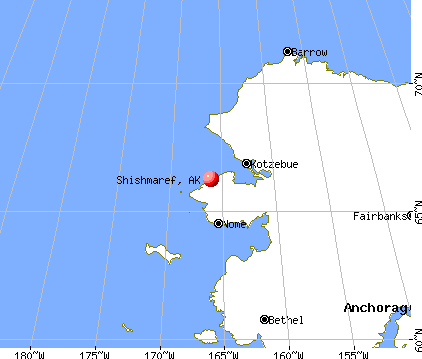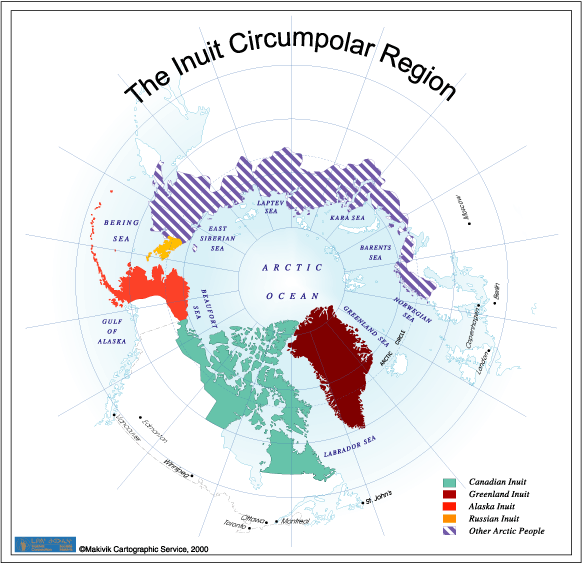Cultural Connections
I took a seminar this fall in Seward focused, in part, on the cyrosphere. But before that, I had never really given earth’s vast frozen water storages much thought – other than to comment on how pretty various ice fields or glacier were in passing.

The video on the Inuit Circumpolar Council’s introduction page has an impressive collection of images of Inuit life. It is not shocking that most of the activities pictured involve some aspect of the cyrosphere.
Climate change is a bigger problem for the Inuit of the Circumpolar Region than it is for the rest of the world because it directly affects every aspect of their daily lives. For the Inuit of Alaska, Canada, Greenland and Russia, global warming is the farthest thing from an abstract concept. Rather, it means they might not have food to eat; they might not have clothing to wear.
The 150,000 Inuit of the Circumpolar Region are represented by the ICC, which was founded in 1977 by Barrow resident Eben Hopson. Because climate change is such a deeply alarming and all-encompassing problem for the residents of the Circumpolar Region, the ICC is in a unique position to comment – and the rest of the world should listen!
It is semi-reassuring to hear that between 2002 and 2006, the ICC has made significant progress “communicating its Arctic manifestations to the world, working with those that hope to mitigate the current and future impacts of climate change, and supporting initiatives that aim to hold those responsible for climate change accountable to Inuit and others that are and will be affected.” However, we know there is still much more to be done.
April, 2009, Indigenous representatives from the Arctic, North America, Asia, Pacific, Latin America, Africa, Caribbean, and Russia met in Anchorage, Alaska for the Indigenous Peoples’ Global Summit on Climate Change. They deemed the climate change problem facing our earth a “climate crisis” that affects all “land, air, water, oceans, forests, sea ice, plants, animals and our human communities” because of the “unbreakable and sacred connection” between all things.

The IPGS Anchorage declaration that they developed at this meeting includes fourteen calls to action. In summary, it demands that states recognize the fundamental human rights of Inuit people to clean lands, air, forests, waters, oceans, sea ice and sacred sites.
That said, the declaration requests that the United Nations Environment Programme (UNEP) assess short-term climate change drivers, particularly black carbon. It asks that the UNFCCC address climate change impacts and support a binding emissions reduction target for developed countries of at least 45% below 1990 levels by 2020 and at least 95% by 2050.
In order to accomplish this, the declaration requests that states think of all resources as interconnected and common among residents of the world. States should pool knowledge and work together, take into account Inuit knowledge, and work to decrease dependency on fossil fuels. States should make the transition to renewable energy as soon as possible.
Additionally, the declaration requests that funds be made available for Inuit people to be involved in climate change monitoring and that risk insurance be available to allow them to recover from weather-related disasters, like some of the the things happening to the houses in Shishmaref.
I showed a different YouTube on Shismaref to my middle school science classes last year during our geology unit when we were studying erosion.

I remember being shocked when I found that video. In viewing Global Warming Threatens Shishmaref, I was no less shocked. It is incredible that
1. The sea ice surrounding the village is frozen all the way to Russia seven months out of the year.
2. 40% of it has melted. And…
3. Shishmaref lost 2,000 feet of coastline in 10 years, taking with it three houses!
In the video, Clifford Weyiouanna explained that whereas the Chukchi Sea used to freeze up in October, it now does not do so until the end of December. There used to be sea ice four-feet thick, but now it is only one-foot thick.
Shishmaref’s ice hunting ground has been significantly disturbed and the villagers are suffering because they are short on food. Huge climate-related storms threaten more of their coastline, homes, and even the airport runway. When the IPGS Anchorage declaration deemed the global warming problem a “climate crisis,” they were right!!!

This is a grave and depressing resource, but also an essential one. It allows viewers to really connect with the sometime abstract concept of climate change, and understand how crucial the problem is to the daily lives of community members right here in our state.
o I like how Arctic Climate Perspectives profiles various Barrow Iñupiaq community members and records their observations of climate change, as well as the effects they see the warmer climate having on their subsistence lifestyles. Like the residents of Shishmaref, Barrow residents are facing food shortages and danger while hunting due to melting ice.

Barrow hunters bring in a seal

Barrow hunters bring in a seal
o I like how at the end of this clip, the Western scientific explanation for the greenhouse effect is included and then connected back to the subsistence culture of Barrow.
o Hunters Navigate Warming Arctic does a nice job of explaining how the hunter, and as a result, his community, are being affected by climate change. Because of the warmer weather, hunting seasons are shortening and prey is becoming scarcer and scarcer.
o I think this resource would be a great way to engage some of the younger middle school boys in my class, who are very into learning how to hunt. It would open their eyes to some of the ways climate change can affect them.
o This resource offers some inspiration to young Alaskans who are interested in conserving the animal and plant resources in our environment.
o I like how Steve highlights a few of the qualifications students will need for this career choice, and ends by saying, “It’s absolutely worth it!” Great endorsement!
o I also like Steve’s comments on not separating the people from the environment – we’ve both influenced each other for thousands of years, now more than ever.
Decreasing sea ice levels could potentially have some dire effects on Arctic animals that depend on the ice for habitat and hunting – such as walruses, polar bears, and seals – among other things. Consequently, the humans that depend on these species for food, clothing, and shelter will suffer. Hunting itself may become very dangerous due to unstable and shifting ice.
Here's a great article I found by D.C. Douglas: "Arctic Sea Ice Decline: Projected Changes in Timing and Extent of Sea Ice in the Bering and Chukchi Seas."
Western Scientific Resources
o This resource explained that the poles help regulate our planet’s temperature. The snow, ice, and clouds here reflect significant amounts of sunlight away from earth, helping to cool the planet.

Sea ice reflecting heat back into atmosphere.

Sea ice reflecting heat back into atmosphere.
o In contrast, the ocean absorbs the heat. This pattern has caused the sea ice in the Arctic Ocean to shrink dramatically in past decades. More open ocean water in the Arctic could lead to increased heat absorption, which will mean more melting sea ice – positive feedback loop!
o It’s possible that the Artic Ocean could be ice-free by the end of the century. This would mean there would be even more open water to absorb heat – and our planet as a whole would be quite a bit warmer!
o Although I found the content of this video interesting, the presentation seemed a little dry. I think it would be hard to keep students’ attention and that it might be better to shorten the resource if I used it in the classroom.
o I liked how Arctic Climate System used visual graphics to explain current patterns that influence the Arctic. These currents bring warmer waters into the Arctic, where the heat can be lost back into space.
o The video footage and audio in How the Arctic Ecosystem Might Change is amazing. This resource does a nice job of explaining the interconnection between all aspects of the food web, and how one tiny change can have widespread effects on the fragile ecosystem.

In the Arctic Food Web, one small change will have widespread effects.

In the Arctic Food Web, one small change will have widespread effects.
o Earth's Albedo and Global Warming is a great interactive. I will definitely use this in my middle school science classes. It uses excellent diagrams and illustrations to explain how ice, water, and soot-covered ice absorb/reflect light differently.
o It then explains the positive feedback loop being created: a warmer planet means more ice will melt, which means more water to absorb the heat (instead of ice to reflect it), which means an even warmer planet. And so on…
o I also really like the interactive Arctic Sea Ice Observations, which explains that one way scientists track snow and ice cover, including sea-ice, is by satellite.
o The features that allow users to compare sea ice levels in 1982 and 2007 and breakup times in 1982 and 2007 are powerful.
Interactive resources offer a hands-on element that video resources cannot. For kinesthetic students (like me!) who process information better when they can manipulate it and take their time to digest it, interactive resources really make a difference. I think it is important to have a balance of different types of resources in a classroom.
NASA’s Page on 2009 Arctic Sea-Ice does a nice job of summarizing the data collected by satellite, and also has some great links:
> Arctic Sea Ice News and Analysis
> NASA Satellite Reveals Dramatic Arctic Ice Thinning
> Satellites and Submarines Give the Skinny on Sea Ice Thickness
> Satellites Show Arctic Literally on Thin Ice
> Arctic Sea Ice News and Analysis
> NASA Satellite Reveals Dramatic Arctic Ice Thinning
> Satellites and Submarines Give the Skinny on Sea Ice Thickness
> Satellites Show Arctic Literally on Thin Ice


No comments:
Post a Comment